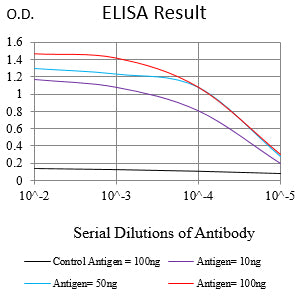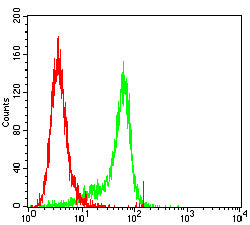

| WB | 咨询技术 | Human,Mouse,Rat |
| IF | 咨询技术 | Human,Mouse,Rat |
| IHC | 咨询技术 | Human,Mouse,Rat |
| ICC | 技术咨询 | Human,Mouse,Rat |
| FCM | 1/200 - 1/400 | Human,Mouse,Rat |
| Elisa | 1/10000 | Human,Mouse,Rat |
| Aliases | A4; STV1; VPH1; VPP2; DRTA3; RTA1C; RTADR; ATP6N2; RDRTA2; ATP6N1B |
| Entrez GeneID | 50617 |
| clone | 4A1F6 |
| WB Predicted band size | 96.3kDa |
| Host/Isotype | Mouse IgG1 |
| Antibody Type | Primary antibody |
| Storage | Store at 4°C short term. Aliquot and store at -20°C long term. Avoid freeze/thaw cycles. |
| Species Reactivity | Human |
| Immunogen | Purified recombinant fragment of human ATP6V0A4 (AA: 228-390) expressed in E. Coli. |
| Formulation | Purified antibody in PBS with 0.05% sodium azide |
+ +
以下是关于ATP6V0A4抗体的3篇代表性文献概览,供参考:
1. **文献名称**:Mutations in the gene encoding B1 subunit of H+-ATPase cause renal tubular acidosis with sensorineural deafness
**作者**:Karet FE, et al.
**摘要**:该研究首次报道了ATP6V0A4(原称ATP6B1)基因突变导致遗传性远端肾小管酸中毒(dRTA)的机制,并开发了特异性抗体用于检测患者肾组织中a4亚基的表达缺失,为疾病诊断提供依据。
2. **文献名称**:The vacuolar H+-ATPase a4 subunit is essential for renal acid-base homeostasis in mice
**作者**:Stover EH, et al.
**摘要**:通过构建Atp6v0a4基因敲除小鼠模型,利用特异性抗体检测发现a4亚基缺失导致远端肾小管酸化功能障碍,证实其在维持酸碱平衡中的关键作用。
3. **文献名称**:Autoantibodies against the a4 subunit of H+-ATPase in systemic lupus erythematosus patients with renal tubular acidosis
**作者**:Li X, et al.
**摘要**:研究发现部分系统性红斑狼疮(SLE)患者血清中存在抗ATP6V0A4自身抗体,可能通过干扰质子泵功能引发继发性肾小管酸中毒,提示该抗体可作为潜在生物标志物。
注:以上文献为示例性概括,实际研究需根据具体实验目的选择抗体相关文献,建议通过PubMed或Web of Science以“ATP6V0A4 antibody”为关键词筛选近年研究。
The ATP6V0A4 antibody targets the ATP6V0A4 protein, a critical subunit of the vacuolar-type H+-ATPase (V-ATPase) complex. V-ATPases are proton pumps responsible for acidifying intracellular compartments, such as lysosomes and endosomes, and regulating extracellular pH in specialized tissues. ATP6V0A4. encoded by the *ATP6V0A4* gene, is specifically expressed in the kidney, particularly in α-intercalated cells of the distal nephron, where it plays a key role in urinary acidification and systemic acid-base homeostasis. Mutations in *ATP6V0A4* are linked to autosomal recessive distal renal tubular acidosis (dRTA), a disorder characterized by impaired urinary acid secretion, metabolic acidosis, and hypokalemia.
Antibodies against ATP6V0A4 are essential tools for studying the localization, expression, and function of this subunit in renal physiology and disease. They are widely used in immunohistochemistry, Western blotting, and immunofluorescence to assess protein distribution in kidney tissues or cultured cells. Researchers also employ these antibodies to investigate pathogenic mechanisms in dRTA models or to validate gene-editing approaches targeting *ATP6V0A4*. Additionally, ATP6V0A4 antibodies may aid in diagnosing genetic forms of dRTA when combined with genetic testing. Their specificity and reliability are crucial for elucidating the role of V-ATPase in cellular energetics, membrane trafficking, and pH regulation across diverse biological contexts.
×